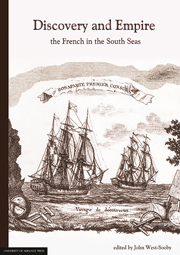Book contents
- Frontmatter
- Contents
- List of Figures
- List of Contributors
- Acknowledgements
- Introduction
- Note on the Second Frank Horner Lecture
- 1 The Globe Encompassed: France and Pacific Convergences in the Age of the Enlightenment
- 2 The Abbé Paulmier's Mémoires and Early French Voyages in Search of Terra Australis
- 3 The Acquisitive Eye? French Observations in the Pacific from Bougainville to Baudin
- 4 Discovering the Savage Senses: French and British Explorers' Encounters with Aboriginal People
- 5 A Case of Peripheral Vision: Early Spanish and French Perceptions of the British Colony at Port Jackson
- 6 New Creatures Made Known: Some Animal Histories of the Baudin Expedition
- 7 “Primitive race”, “pure race”, “brown race”, “every race”: Louis Freycinet's Understanding of Human Difference in Oceania
- 8 Imperial Eyes on the Pacific Prize: French Visions of a Perfect Penal Colony in the South Seas
3 - The Acquisitive Eye? French Observations in the Pacific from Bougainville to Baudin
Published online by Cambridge University Press: 05 April 2014
- Frontmatter
- Contents
- List of Figures
- List of Contributors
- Acknowledgements
- Introduction
- Note on the Second Frank Horner Lecture
- 1 The Globe Encompassed: France and Pacific Convergences in the Age of the Enlightenment
- 2 The Abbé Paulmier's Mémoires and Early French Voyages in Search of Terra Australis
- 3 The Acquisitive Eye? French Observations in the Pacific from Bougainville to Baudin
- 4 Discovering the Savage Senses: French and British Explorers' Encounters with Aboriginal People
- 5 A Case of Peripheral Vision: Early Spanish and French Perceptions of the British Colony at Port Jackson
- 6 New Creatures Made Known: Some Animal Histories of the Baudin Expedition
- 7 “Primitive race”, “pure race”, “brown race”, “every race”: Louis Freycinet's Understanding of Human Difference in Oceania
- 8 Imperial Eyes on the Pacific Prize: French Visions of a Perfect Penal Colony in the South Seas
Summary
When Nicolas Baudin returned to France in June 1798 following his successful expedition to the West Indies, the Director of the Paris Museum, Antoine-Laurent de Jussieu, was moved to write to the Minister of Marine and the Colonies recommending that another scientific mission be entrusted to this “excellent mariner” so that the nation might benefit further from his talents. In his enthusiasm, Jussieu declared that “the experience of the past and the knowledge of his former achievements make us believe that he follows worthily in the steps of Bougainville, La Pérouse and d'Entrecasteaux, and that he will be more fortunate than the last two.” Just under two years later, Jussieu would be granted his wish: in April 1800, the First Consul, Bonaparte, signed off on a proposal for a new voyage of discovery to the Southern Lands, under the command of Nicolas Baudin. The fates—or as one member of Baudin's team would have it, Clio, the Muse of History in person—seemed to have smiled upon the newly commissioned captain.
Despite Jussieu's firm belief, however, the captain was not to enjoy a happier fate than La Pérouse or d'Entrecasteaux, nor did Clio's patronage extend to the voyage itself. For Baudin had enemies, and they were so successful in blackening his reputation that they managed to cast a shadow over the entire undertaking.
- Type
- Chapter
- Information
- Discovery and EmpireThe French in the South Seas, pp. 69 - 98Publisher: The University of Adelaide PressPrint publication year: 2013



